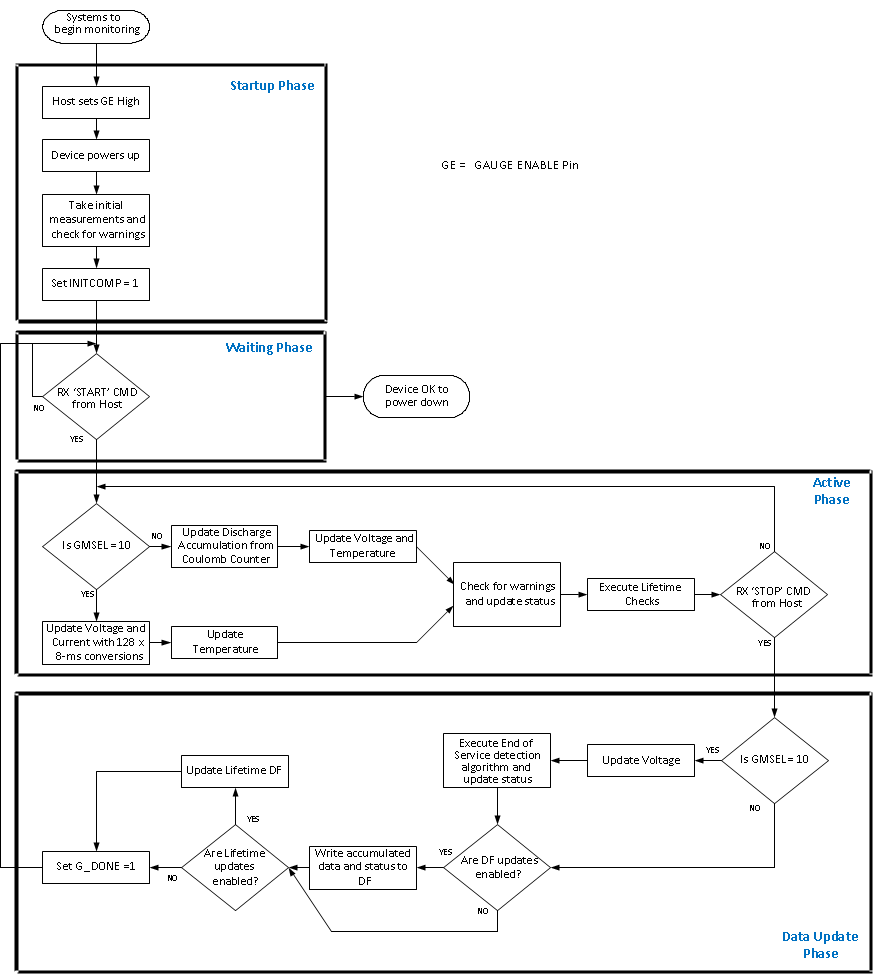JAJSCB3E June 2016 – April 2019 BQ35100
PRODUCTION DATA.
- 1 特長
- 2 アプリケーション
- 3 概要
- 4 改訂履歴
- 5 Pin Configuration and Functions
-
6 Specifications
- 6.1 Absolute Maximum Ratings
- 6.2 ESD Ratings
- 6.3 Recommended Operating Conditions
- 6.4 Thermal Information
- 6.5 Power Supply Current Static Modes
- 6.6 Digital Input and Outputs
- 6.7 Power-On Reset
- 6.8 LDO Regulator
- 6.9 Internal Temperature Sensor
- 6.10 Internal Clock Oscillators
- 6.11 Integrating ADC (Coulomb Counter)
- 6.12 ADC (Temperature and Voltage Measurements)
- 6.13 Data Flash Memory
- 6.14 I2C-Compatible Interface Timing Characteristics
- 6.15 Typical Characteristics
-
7 Detailed Description
- 7.1 Overview
- 7.2 Functional Block Diagram
- 7.3 Feature Description
- 7.4 Device Functional Modes
-
8 Application and Implementation
- 8.1 Application Information
- 8.2
Typical Applications
- 8.2.1 Design Requirements
- 8.2.2
Detailed Design Procedure
- 8.2.2.1 Preparation for Gauging
- 8.2.2.2 Gauging Mode Selection
- 8.2.2.3 Voltage Measurement Selection
- 8.2.2.4 Temperature Measurement Selection
- 8.2.2.5 Current Sense Resistor Selection
- 8.2.2.6 Expected Device Usage Profiles
- 8.2.2.7 Using the BQ35100 Fuel Gauge with a Battery and Capacitor in Parallel
- 8.2.3 EOS Mode Load Pulse Synchronization
- 8.2.4 Benefits of the BQ35100 Gauge Compared to Alternative Monitoring Techniques
- 8.2.5 Application Curves
- 9 Power Supply Recommendations
- 10Layout
- 11デバイスおよびドキュメントのサポート
- 12メカニカル、パッケージ、および注文情報
パッケージ・オプション
メカニカル・データ(パッケージ|ピン)
- PW|14
サーマルパッド・メカニカル・データ
- PW|14
発注情報
7.4 Device Functional Modes
The BQ35100 device is intended for systems where the battery electronics are required to consume a very low average current. To achieve this, the device is intended to be fully powered off when not required through control of the GAUGE ENABLE (GE) pin. When this pin is low, then the device is fully powered down with no measurements being made and no data, unless in flash, is retained.
An example system current profile is shown along with the state of GAUGE ENABLE to reduce the average power consumption of the battery electronics.
 Figure 10. Power Consumption
Figure 10. Power Consumption The average power consumption of the BQ35100 device is an average of the periods where GAUGE ENABLE is high AND low over a given period.
For example, if the system enters a high power state (500 µA) for 30 s every 4 hours, the average current will be:
When GAUGE ENABLE is low (GE = Low), then the device is powered off and the current is nominally ICC_GELOW, and is the leakage current into the REGIN pin. Other components connected to this node should also be evaluated to determine the "System Off" current total.
When the device is used for gas gauging, it transitions through several power states based on the selection of OperationCfgA[GMSEL].
Figure 11 highlights the operational flow and conditional decisions.
 Figure 11. Operational Flow
Figure 11. Operational Flow